.
SITE GUIDE
REVIEWS
FEATURES
NEWS
Etcetera and
Short Term Listings
LISTINGS
Broadway
Off-Broadway
NYC Restaurants
BOOKS and CDs
OTHER PLACES
Berkshires
London
California
DC
Philadelphia
Elsewhere
QUOTES
On TKTS
PLAYWRIGHTS' ALBUMS
LETTERS TO EDITOR
FILM
LINKS
MISCELLANEOUS
Free Updates
Masthead
Writing for Us
A CurtainUp Feature
2006 Shaw & Stratford Festival
With phographs by Lucy Ann Saltzman
|
As we all know the man can talk, but Bernard Shaw is also one of the most prescient, provocative, sparklingly articulate writers in the English language. His words and ideas, expressed in plays that are well-known. . . It is a joy to draw attention to those ideas and bring them to life on our stages.-- Jackie Maxwell, Shaw Festival Artistic Director |
THE TALE OF TWO FESTIVALS
PRODUCTIONS SEEN AT THE SHAW FESTIVAL
PRODUCTIONS SEEN AT THE STRATFORD FESTIVAL
|
Editor's Note: The years go by but George Bernard Shaw's work retains its luster which The Shaw Festival in Niagara-on-the-Lake in Ontario continues to burnish each year by presenting his plays and plays about the period of Shaw’s lifetime. Perhaps it was Shaw's dedication to his ideas that inspired James Moore who wrote about the Festival for CurtainUp last year (Festival 2005 Feature) to take time out to run for Congress from the state of Kentucky. He lost, but he's got Shaw's spirit of activism so expect to see and hear more from him on the political front -- with hopefully, some time to spare for theater going. Shaw Festival Web Site Stratford Festival Web Site |
THE TALE OF TWO FESTIVALS
No two Shaw plays could be more impudently topical or more eminently illuminating in the light of today’s political climate than the rarely produced satire Too True To Be Good, and the relentlessly popular farce Arms and the Man in repertory at this year's Shaw Festival. And what an interesting juxtaposition there is with two of plays by the Bard at the Stratford Festival. In Much Ado About Nothing, audiences see how a young lover’s strict adherence to social proprieties leads him into a trap. Conversely in Coriolanus audience's see how an arrogant war hero’s failure to adhere to social priorities leads to his death.
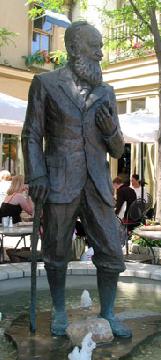
A great in between shows spot for people watching near Shaw's statue
|
The Shaw Festival employs a core of approximately 60 to 80 actors for the season that runs from February through October. Up to 110 actors may be cast in one season alone. According to Jackie Maxwell, the artistic director for the past 4 years, the Festival employs a total of 600 people compromising all facets of the Festival’s day to day operations and productions. Only a couple of hours driving time from each other, visitors might well consider splitting the week, as we did, and not forgo the distinct pleasures that each offers. A bonus trip to Toronto to see The Lord of the Rings was a special treat that proved to be an unexpected delight. The news that this $28 million fantasy adventure spectacle has announced that it will close on September 3rd should give you an incentive to see an amazing and budget-be-damned production that you are not likely to see again in your lifetime.

River scene that's the 'backyard' of the Stratford Festival Theatre.
|
Although grateful and eager to be part of a conference during which panels and discussions on different aspects of theater and critical analysis were on the agenda, as planned by the ATCA conference chairs, it was the meeting and convening with the collective and collaborating artistic and business staffs of both the Shaw and Stratford Festivals that added a special dynamic to the week in this beautiful part of the country. Whether you are dining leisurely at the Niagara-On-The-Lake golf club located on the banks of Lake Ontario, taking a carriage ride to admire the quaint "toy" town, or simply hobnobbing with strangers enjoying a scrumptious ice cream creation while strolling down bustling Queen Street, the non-theatrical events also rate. In Stratford, it is the calming ripples of the Avon that lure you from the sprawling grounds of the Festival Theater and prompt you to walk its beckoning romantic route past the Tom Patterson Theater (one of the Festival’s four theaters) to the heart of the downtown area. I found both Niagra-On-The-Lake and Stratford examples of the pure exaltation of good theater in meticulously maintained and invigorating surroundings notably dedicated to the intelligent and the discriminating visitor.
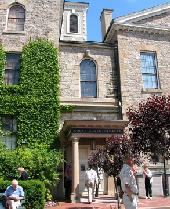
The Shaw Courthouse Theatre in Niagara on the Lake
|
THE SHAW FESTIVAL. You may not be able to hear the thunder of Niagara Falls, located only 20 minutes away from the center of the historic village of NOTL, but the thunder of applause rarely stops coming from the town’s 3 theaters Court House Theater, Festival Theater, and Royal George Theater – where the works of George Bernard Shaw (1856 to 1950) as well as those of his contemporaries (plays written in his lifetime) are performed daily in dizzying repertory style.
In 2000, the Festival introduced a mandate that would expand from the original mission to revitalize and re-energize the works of Shaw. Under Maxwell’s continuing artistic leadership, the Festival this year stretched the boundaries a bit further: "to look at the mandate from the outside as well as the inside to provide creative friction by juxtaposing the old and the new, and with Canadian work, to let us hear and promote our own stories and our own points of view. I want the Shaw Festival to be the place where classic Canadian and contemporary plays can be given a uniquely detailed, thoughtful and vivid new life." To this end Maxwell included a play not written by a Shaw contemporary, The Magic Fire by Lillian Groag. It takes place in 1952 Buenos Aires. Unsurprisingly, it is directed by Ms. Maxwell and is a highlight of the Shaw Festival.
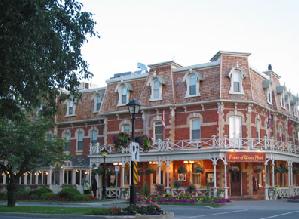
The Prince of Wales where we enjoyed princely accommodations.
|
A stunning example of this was at NOTL’s main Festival Theater where one can not helped being awed by how efficiently the Oyster Bay Long Island settings for the musical High Society can be quickly dismantled after the performance in order for a turn-of-the-century home in Bulgaria to arise for Arms and the Man -- and in turn be replaced by 17th century Salem, Massachusetts for The Crucible. They are struck and then erected within the space of a few hours, only to be repeated again and again.
At both the Shaw and Stratford Festivals, it is, besides the high quality of the acting, the stamina and versatility of the resident actors that is sure to impress you as it did me. At Stratford, an impressive Colm Feore embodied the master pickpocket Fagin with a beard and a raggedy coat in a stupendous production of the musical Oliver at a matinee performance and a few hours later was dressed in his uniform of the Roman leader Coriolanus. Need it be said that he was as frolicsome in the former as he was formidable in the latter. This reappearance of an actor one has just seen a few hours earlier as someone else in something else is a constant source of amazement.
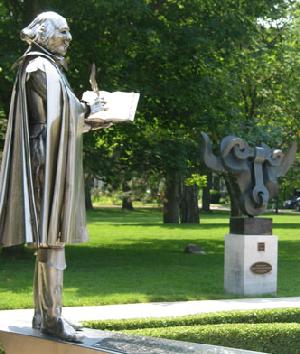
Art is everywhere at the festivals, like this
statue of Shakespeareis in front of the Festival Theatre in Stratford.
|
Between plays, visitors will undoubtedly be impressed with the examples of Victorian, Regency and Edwardian architecture that define the gentle and pristine look of the town carefully maintained since the birth of the Festival in the mid 1960s. NOTL has many boutiques, galleries, shops, bed and breakfasts, inns and luxury hotels to accommodate visitors. ATCA members and guests had the privilege of being escorted through the Peller Estates, one of NOTL’s 15 award-winning wineries where we were also treated to an elegant sit-down dinner featuring pheasant. Many wineries offer tours.
PRODUCTIONS SEEN AT THE SHAW FESTIVAL
Paragraph headed "Productions seen at Shaw" brackets instead of parens needed within the parens [(Other productions, not reviewed, include The Heiress, The Invisible Man, Design for Living, Rosmersholm, and Love Among the Russians (umbrella title for Chekhov’s one-act plays The Bear and The Proposal) Except where noted, all productions run in repertory through November 19th.)]
The Magic Fire. While it is wonderful to see American author Lillian Groag’s play getting a first-rate production at the Shaw Festival, it is also unfortunate that New Yorkers have yet to have an opportunity to see this beautifully dramatized memory play that won the Kennedy Center Fund for New American plays in 1977 and was produced there in 1998. To my knowledge, it last appeared in the tri-state area at Philadelphia’s Wilma Theater in 2002. At any rate, it is worth the trip to the Festival to see this poignant, exquisitely acted drama about a family living in Buenos Aries in the 1950s during the time of the Perons. Notwithstanding that their lives are growing a bit desperate and unsettled in a growing police state, the conflicts that arise from their respective Italian and Austrian heritages come into play with humor and with Groag’s obvious adoration for the twelve characters and their disparate personalities -- each one fully dimensional and with the richness of detail. Because we saw an early preview, ATCA reviewers were asked not to write reviews. So I will refrain from commenting on more than how splendid was both Tara Rosling as the play’s narrator and principal character and Lila Bata-Walsh, as her precocious younger self. The excellence of Jackie Maxwell’s direction will also remain a secret. Court House Theater (through October 8th)
Too True To Be Good. You will either loath or love this rare bird by Shaw whose preference for long-winded prose apparently reached its nadir (or its zenith depending on your perspective) when he was 75 years old. This was an introduction for me to this talk-fest that begins with a microbe bemoaning the fact that the young rich girl lying in a sick bed is the cause of his illness. Absurdities follow each other as a pair of burglars enter the ailing girl’s room and convince her to escape her smothering life and join them in a life of conning and chicanery. What starts out as fun quickly digresses into a series of inscrutable speeches given on a sea beach by a pompous colonel, a religious sergeant, a know-it-all private, and a conflicted agnostic, all of whom have their say on every controversial topic known to man, without connecting the dots. It is, in fact, quite dotty. But it is exquisitely acted and smartly directed by Jim Mezon. Overheard at the end of the play: "It’s simply brilliant." And from another theater-goer: "Why would they name a festival after someone who wrote such a terrible play?" to October 7th at the Court House Theater.
High Society. Speaking of why would. . .brings us to the Shaw Festival’s production of the musical High Society, the only indisputable disappointment of the lot. Starting out as The Philadelphia Story, this high comedy of manners by Philip Barry was subsequently twice successfully transferred to the screen --first with Katherine Hepburn as the skittish socialite Tracy Lord and later by Grace Kelly in a musical version with an infectious score by Cole Porter. Both were harmless and amusing. However, a strained unamusing Broadway version patched together with additional but unsuited songs from the Porter catalogue faded away after a paltry four months. It’s hard to know what director Kelly Robinson and choreographer John MacInnis had in mind, but collaboratively they seem intent on keeping the inane cavorting of a bunch of obnoxiously portrayed characters moving through the mobile settings as fast as they can, hopefully to divert our attention from the abrasive singing and dismaying acting of Camilla Scott, as Tracy Lord. The Festival Theater (through November 19th)
Arms and the Man. Shaw’s most charmingly satiric farce takes place at the turn of the 20th century in Bulgaria. The war with Serbia is nearing its end but it’s just the beginning of a raucous romantic adventure involving Bluntschli (Patrick Galligan), a philosophical Swiss mercenary soldier fleeing his pursuers, Rainia (Diana Donnelly), the impetuous daughter of a Bulgarian major who gives him refuge, and Sergius (Mike Shara), a vain Bulgarian officer and Raina’s betrothed. The performances, under Jackie Maxwell’s direction, are all geared to achieve the maximum number of laughs that come virtually non-stop from start to finish. The handsome production is marked by three stunning sets by Sue LePage and a feast of colorful wittily over-the-top costumes by William Schmuck. Festival Theater. (through October 29th)
The Crucible. The topicality and enveloping power of Arthur Miller’s play about the Salem witch trials in 1692 and one man’s determination to remain true to himself and his principals remains potent dramatic fare. That there are no scene-stealers among the excellent cast may be due in part to a lack of dramatic urgency in Tadeusz Bradecki’s sprawling staging. However, considering the inherent allusions to the McCarthy era in the text, and its concentration of fear-inducing political and religious ranting, the play will continue to accomplish its task and affect audiences who are seeing it for the first time. And what a treat to see accomplished actor Jennifer Phipps as the imperiled Rebecca Nurse only one day after seeing her sterling portrayal as the out-spoken Italian grandmother in Magic Fire. Festival Theater (through October 14th)
Back to Top
PRODUCTIONS SEEN AT THE STRATFORD FESTIVAL OF CANADA
Much Ado About Nothing. One can presume there is a back-story when two directors, Stephen Ouimette and Marti Marden, are credited. Be that as it may, this stately almost monochromatic production of Shakespeare’s popular comedy gracefully considers its potential as a romance for older lovers. That the famously bickering Beatrice and Benedick should be seen as decidedly middle-aged is not only a pleasant idea, but as played by a somewhat world weary looking Peter Donaldson and a love-me-like-I-am-or-leave me Lucy Peacock, they seem not only a little less raucous but more formidably armored for what we can presume to have been a very long and exhausting courtship. The production’s sedate tone also affects our response to the infuriating courtship of Hero and Claudio, as played by Adrienne Gould and Jeffrey Wetchfar. For one who is not disposed to laughing at the comedy bits, they are not readily apparent. At any rate, this new variation on an old war-horse just struck my fancy. At the Festival Theater. (through October 22nd)
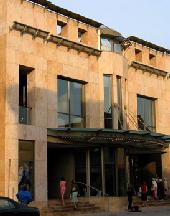
The Avon Theatre in Stratford
|
Oliver.Lionel Bart’s musical version (what a wonderful score!) of the Dickens classic is a charmer and remains so under the exuberant direction of stager and choreographer Donna Feore. Despite the wonder of designer Santo Loquasto's spectacular and atmospheric multi level setting and knockout costumes, it is the performances that make this show a winner. No need to repeat my earlier praise of Colm Feore as Fagin, except to say that as impressive as he is as musical theater performer (great voice and panache), he doesn’t steal the thunder from young, appealing and very talented Tyler Pearce in the title role -- or Scott Beaudin as the Artful Dodger, Blythe Wilson as Nancy (stopping the show with her impassioned "As Long As He Needs Me"), or a superb supporting cast whose singing and dancing affords the show’s its dramatic heft. My only quibble might be the way the extended and exuberant ensemble dance numbers too often jar the show from its more somber course and are hardly evocative of Dickensian London. But I suspect that kind of divertissement is typical of the era in which it was conceived. At the end, however, you do want to stand up and shout like Oliver in the workhouse, "Please sir, I want some more." The Festival Theater (through October 29th)
Coriolanus. This is a grand opportunity to see a gripping staging of one of Shakespeare’s more rarely produced historical tragedies. Under the ungimmicky no frills direction of Antoni Cimolino, Colm Feore gives a commanding performance as Caius Marcius Coriolanus, the legendary Roman hero of the 5th century B.C. who after defeating the Volsces and their leader Aufidius, is maneuvered against his will by the Patricians into becoming a tribune of the Plebeians. Feore dominates the action. His speeches define him as arrogant, prideful and conceited, but we are equally intrigued by his obstinacy. In short, Coriolanus’ attitude doesn’t sit well with the politicos in charge and it proves to be his undoing. This is a play fueled not only by power politics but by provocative relationships. The brawny Graham Abbey is another dynamic presence as Aufidius, who is first a foe and then an ally of Coriolanus. Martha Henry is coolly manipulative as Coriolanus’ mother. Battle scenes ignite with regularity between the conspiracies afoot making this late and lengthy play worthy of our rapt attention. And what about the plays political topicality in which we see a man ill-suited for a job of leadership manipulated by those who would use him as a pawn to their ends? Festival Theater (through September 23)
Back to Top

Easy-on-the budget super gift for yourself and your musical loving friends. Tons of gorgeous pictures.

>6, 500 Comparative Phrases including 800 Shakespearean Metaphors by our editor.
Click image to buy.
Go here for details and larger image.







